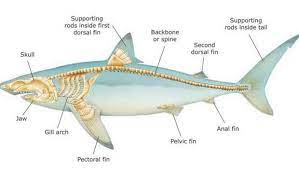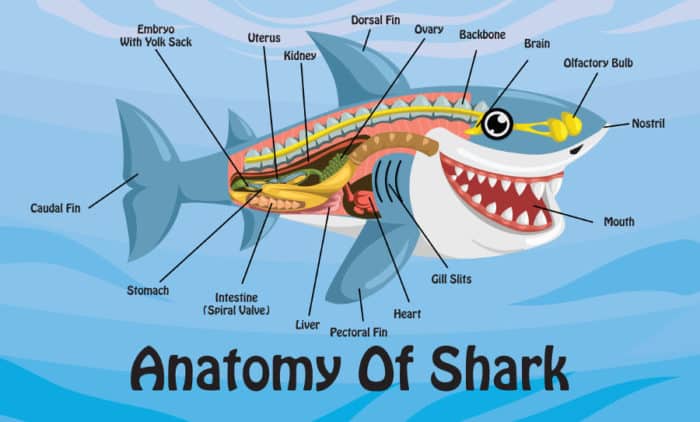

Sharks are a number of the most infamous and feared predators within the world, observed in every ocean and some rivers. They’re regularly referred to as “living fossils” as they have got roamed the oceans for more than four hundred million years, meaning they were even around before the dinosaurs. however, despite how long they’ve been around there’s nonetheless extra to study them. There’s one query that often comes up when we’re discussing sharks, and that is whether they’ve bones or now not. truly something as effective and ferocious as a shark needs to have bones even though? join us as we study all approximately sharks and discover whether or not they Do sharks have bones?
Many animals have a skeleton that is made from bone and it gives their body form and offers them energy. So, considering that sharks are one of the maximum effective predators within the ocean and have a splendid chew force, it would be clean to expect that they ought to have difficult bones. but, sharks are from the elegance Chondrichthyes which means “cartilage fish”, rather than Osteichthyes are bony fish. they are additionally from the subclass Elasmobranchii which incorporates all sharks, rays, skates, and sawfish. As sharks are cartilaginous fish they have got a skeleton this is crafted from cartilage rather than bone. In reality, they don’t have an unmarried bone of their bodies!
Cartilage is tissue that is softer and greater bendy than bone. but, even though sharks have a cartilaginous skeleton miles are still tough and do exactly the identical task that a skeleton crafted from bone does. It gives their bodies shape and structure and protects their organs.
Having a flexible skeleton lets sharks open their mouth further and exert a more bite force
Having a skeleton this is crafted from cartilage as opposed to bone is an excellent advantage to sharks and is one of the reasons that they may be such capable and powerful predators. Cartilage is a whole lot lighter than bone that’s important due to the fact sharks don’t have a swim bladder. rather, they need to depend on their massive oil-crammed liver to offer them buoyancy. consequently, a simply heavy skeleton might be a major disadvantage to them. also, as cartilage is plenty extra bendy than bone it additionally allows sharks to swim fast and make brief turns after they’re chasing prey.
some other benefit of getting a cartilaginous skeleton is that it lets in the shark’s jaw to be an awful lot greater flexibility. which means that they are capable of opening their mouths plenty wider than they might if they had a jaw crafted from bone. As they could open their mouths wider they’re able to exert an awful lot of extra downward force in their chew. this is why sharks have a number of the best chunk forces around and makes them some of the most savage predators in the ocean. but, sharks’ snouts are crafted from especially tender and bendy cartilage. because of this their snout can act as a bumper and can absorb heavy blows without struggling a lot of harm.

Sharks are classed as vertebrates, which means that they have got a spine. but how can they have got a backbone if they don’t have bones? The fact is that an animal doesn’t should have a spine made from bone to be a vertebrate. Sharks have a spinal column this is crafted from cartilage much like the relaxation of their skeleton. It protects their spinal wire precisely in an equal manner that one crafted from bone does. that is due to the fact the cartilage that makes up the spinal column of the shark is calcified. because the cartilage is calcified it is difficult sufficient to offer vital protection to the spinal wire.
As we’ve already referred to, sharks had been around for a genuinely long term, and at that point, they’ve evolved an exquisite deal. however, did prehistoric sharks additionally have cartilaginous skeletons, or did they truly have bones? the important thing to coming across the answer is to study the fossil document. The earliest fossil report of sharks is a few scales that date returned to 450 million years ago. Then there are a few shark teeth from 410 million years in the past. All of the manner via the fossil file it’s only shark tooth, dermal denticles, and vertebral centra (dorsal fins) – no bones. therefore, as there are no fossilized shark bones found it’s quite secure to mention that every one shark – or even their earliest ancestors – has had cartilaginous skeletons in preference to bones.
Cartilage doesn’t fossilize nicely due to the fact it is a whole lot softer than bone and breaks down quickly. but, some cartilage (which includes parts of the jaw, vertebrae, and dorsal fin) are calcified which makes them an awful lot harder. As this cartilage is a great deal harder it can be fossilized, even though it is still discovered best very not often.
Shark teeth are a part of sharks that are most typically fossilized. apart from it being due to the fact they’re the toughest part of a shark (made from dentin that’s more difficult than bone), it’s also because there are so lots of them. Sharks usually simply update misplaced or worn down enamel – the vintage best drop out and new ones take their place. which means full-size, tremendous numbers of shark teeth have dropped to the ocean ground over millions of years. This substantially increases the risk of them ending up fossilized in comparison with the dermal denticles and dorsal fins.
The apparent solution to that is, of direction, none. We’ve already installed that sharks don’t have any actual bones.
the quantity of cartilage would be tough to count since it’s truly connective tissue. So answering how plenty cartilage is in a shark is difficult to do.
but, it’s less complicated to answer wherein a shark has cartilage to affect how much of the supple substance there is. You’ll discover cartilage in a shark’s backbone, fins, head, and jaw.
So, large sharks can have extra cartilage than smaller species definitely because they have bigger bodies to fill.
amusing truth: Sharks haven’t any rib cages, now not even ones made from cartilage. So if you decided to hug a shark (which isn’t always recommended) it would sense surprisingly squishy. this will also make living out of the water extremely uncomfortable for sharks.
There might not be a specific purpose why sharks have a boneless skeleton. there’s a notion that hundreds of years ago, the ancestors of the modern shark did have bones.
Many scientists consider that sharks have in view that advanced to have cartilage skeletons in preference to dense bone vertebrae.
over the years, the various shark species evolved to a better life in their habitats. This, it seems, resulted in them becoming cartilaginous fish instead.
This evolution in all likelihood performed a huge element in sharks turning into the scary predators that they’re today. without their lightweight, flexible skeletons, they wouldn’t be able to prevent their very own predators as speedy.
Nor might they be such speedy swimmers, or be able to trap their prey as fast and seamlessly as they do.
It may seem confusing, but even though sharks have a lack bone, their bodies do have skeletons.
A shark skeleton is a bit different from other vertebrate species. Interestingly, most of a shark’s muscles don’t connect to the skeleton.
A cool-looking fish with an oversized snout has come to be the most primitive jawed vertebrate to have its genome sequenced. The DNA series of the elephant shark facilitates to explain why sharks have a cartilaginous skeleton and how human beings and other vertebrates advanced received immunity. which are associated with sharks and rays. They patrol the deep waters off southern Australia and New Zealand and use their different snouts to hunt for shellfish buried within the sand. even though elephant sharks are not regarded to attack human beings, they game a seven-centimeter-lengthy spike on their dorsal fin, that is used to shield against predators.
Six years in the past, scientists singled out C. milii as the first cartilaginous fish to be sequenced because of its exceedingly small genome — about one-0.33 the scale of the human genome. “we have had many genomes for amphibians, for birds, and mammals, however no sharks,” says examine author Byrappa Venkatesh, a comparative-genomics expert on the company for technological know-how, era and research in Singapore.
Due to the fact, the elephant shark is an early jawed vertebrate and has changed little because bony fishes appeared around 420 million years in the past — making it the slowest-evolving of all regarded vertebrates — it serves as a critical baseline for comparative genomics. “we’re going to use this as a reference for years to come,” Venkatesh says. The genome was posted nowadays in Nature1.
up to now, scientists have sequenced the genomes of eight bony fish and two jawless vertebrates called lampreys. Sharks, skates, rays, and chimeras stand other than other jawed vertebrates in having a skeleton this is made generally of cartilage rather than bone. although scientists knew what genes had been concerned in bone formation, it wasn’t clear whether sharks had misplaced their bone-forming capacity or just in no way had it in the first place. in the end, sharks do make bone in their teeth and fin spines.
The collection reveals that participants of this organization are missing an unmarried gene circle of relatives that regulates the manner of turning cartilage into the bone and that a gene duplication event gave rise to the transformation in bony vertebrates. In reality, while the researchers knocked out this kind of equal genes in a zebrafish, it significantly decreased its potential to shape bone.
John Postlethwait, a developmental biologist at the University of Oregon in Eugene, calls the findings “illuminating”. He research Antarctic icefish (Notothenioidei), which lost the potential to form bone throughout evolution, and could look to peer whether or not they lack the equal genes which are lacking from the elephant shark genome.
Read More:
24World Media does not take any responsibility of the information you see on this page. The content this page contains is from independent third-party content provider. If you have any concerns regarding the content, please free to write us here: contact@24worldmedia.com

A Brief Look at the History of Telematics and Vehicles

Tips for Helping Your Students Learn More Efficiently

How To Diagnose Common Diesel Engine Problems Like a Pro

4 Common Myths About Wildland Firefighting Debunked

Is It Possible To Modernize Off-Grid Living?

4 Advantages of Owning Your Own Dump Truck

5 Characteristics of Truth and Consequences in NM

How To Make Your Wedding More Accessible

Ensure Large-Format Printing Success With These Tips

4 Reasons To Consider an Artificial Lawn

The Importance of Industrial Bearings in Manufacturing

5 Tips for Getting Your First Product Out the Door